The
Iaido Journal Dec 2009
A Visit to Mt. Koya
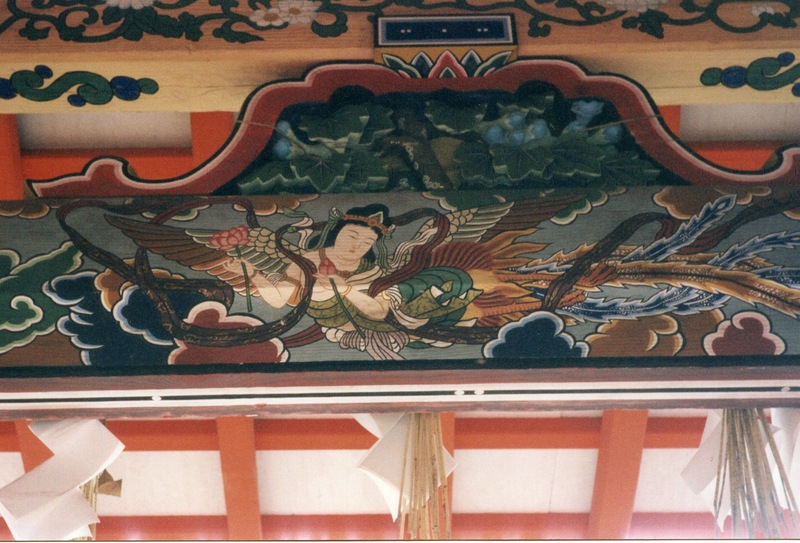 A sacred figure adorns a gate in Koyasan (17th century)
A sacred figure adorns a gate in Koyasan (17th century)
Text and photos by Deborah Klens-Bigman, Ph.D.
In
the Heike Monogatari, a tale of the Gempei War (1180-1185), many doomed
members of the Taira clan made a pilgrimage to Mt. Koya before being
forced to end their lives. The tragedy of the Heike is depicted
as a lesson in the perils of hubris, which resulted in the destruction
of a once-powerful clan. The pilgrimages to Mt. Koya are seen in
the text as a way for individuals (often without particular blame
for the tragic events) to not only ask forgiveness for their
personal sins, but to also somehow atone for the reckless behavior of
the clan as a whole. Even to an outsider, the story of the Heike
clan evokes pity for the sufferings of the innocent and not-so innocent
alike.
However, until I went there myself, I had no idea of the
significance of the place. And I can say that after several
visits to the sacred mountain, I am taxed to explain its hold on me -
maybe a sense that a place that has been venerated by millions of
people for over a thousand years leaves an emotional impression on
(essentially) non-Buddhist, somewhat spiritual types like myself.
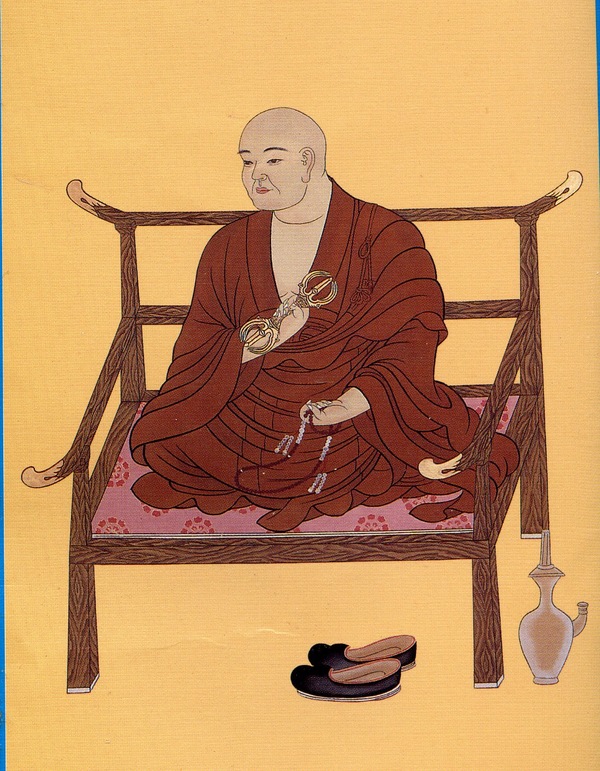
Kobo Daishi (Kukai), from a scroll on sale in a gift shop.
Mt.
Koya is the seat of Shingon Buddhism, a sect founded at the beginning
of the Heian Period (794-1185) by priest/scholar Kobo Daishi (also
called Kukai) (774-835). After his early education, Kobo Daishi
sama journeyed to China in 804 in order to deepen his understanding of
Buddhism. Though he expected his study to take much longer, his
abilities allowed him to return to Japan in 806, after which he
continued to teach and write. In 816, his petition to the Emperor
Saga was granted to build a retreat in this remote (but not
inaccessible) part of Japan. Koyasan has since then been
considered a sacred place and a destiny of pilgrims for centuries
(Koyasan Shukubo Assoc. n.d.).
Shingon places emphasis on an
individual's ability to attain enlightenment by her own efforts,
through various means depending on the individual. As an
“esoteric” sect, emphasis is placed on transmission of teachings from
teacher to student. With approximately 14 million followers,
Shingon is the third-largest Buddhist sect in Japan. There are
small Shingon temples in foreign countries as well (Thaler n.d., n.p.).
Kobo
Daishi sama had other, more secular accomplishments as well. In
addition to public works projects, he is credited as the legendary
creator of hiragana, the syllabic script for writing the Japanese
language that exponentially increased literacy in the country.
Hiragana is still in common use, and is the first writing system
learned by both elementary school kids and foreigners alike. In
Kobo Daishi sama's time, it was sometimes considered "women's hand"
since it was considered unladylike to learn the complex Chinese
characters used in more scholarly writing. As a perpetual student
of the language, I owe him a real debt. There are stories of him
as a master calligrapher, including a personal favorite of mine:
Kobo Daishi sama was once commissioned to write a sign that was placed
above a daimyo's gate. Once the sign was mounted, the daimyo
noticed the Japanese ideogram was incorrect in that it was missing a
dot that made up the correct character. Kobo Daishi sama was
summoned to correct the mistake. While waiting for a servant to
bring a ladder around, Kobo Daishi sama simply threw his calligraphy
brush at the sign, corrected the error, and caught the brush when it
fell back down. The moral of the story is that "even Kobo Daishi
sama sometimes made mistakes," a sentiment that once earned me a
sympathetic chuckle from my iai teacher instead of a growl of criticism
over some error I had made in practice (Davis 1992, 234, 237).
While
getting to Koyasan is not the ordeal it must have been for the
unfortunate members of the Heike clan, it nevertheless feels not so
much like a journey back in time as a journey to a place out of
time. The easiest way is to go from Osaka's Namba Station,
located in a lively area of shops, nightclubs and restaurants in one of
the most modern cities in the world. There is a super-express
train, which I never seem to be able to get, so I settled for an
"express" train that is really more like a local, going in an almost
straight line out of the city, to ever smaller suburban towns, and
across a flat plain of rice fields, the mountains looming up
dramatically in the distance. After about 90 minutes, we changed
for a small "one man" train that climbs up a single track, pausing
occasionally on siderails for a descending train to pass. On my
last visit, in May 2009, the railway sidings were banked in spring
flowers. Mixed forests of bamboo and other trees eventually gave
way to very tall, straight pines. As the train wound on, the
passengers diminished until there were a few tourists and pilgrims left
(pilgrims are distinguished by their white clothing, and sometimes
carry staffs and wear sedge hats).
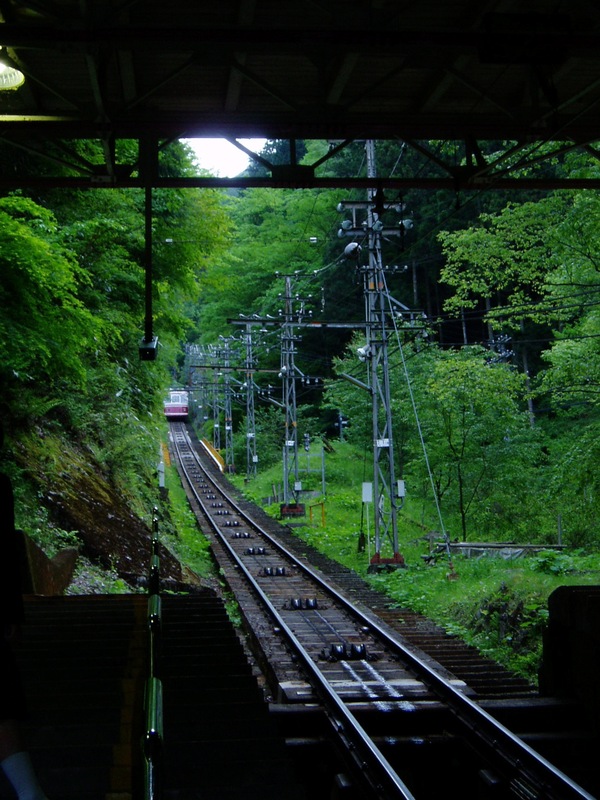 The cable car emerges from the trees as it arrives at the station at Koyasan.
The cable car emerges from the trees as it arrives at the station at Koyasan.
Finally,
we reached the end of the line, and carefully made our way up a steep
incline to a small cable car for the last, almost scarily
vertical, ascent. Once on board, a friendly,
recorded voice welcomed us and explained in English and Japanese
that the area is a UN-designated World Heritage Site. I have
sometimes wondered if the friendly recording (complete with soothing
background music) is to distract us from the nerve-racking feeling of
being hoisted up the side of the mountain. The pilgrims, in
particular, never seem to be concerned about being suspended in a small
car by what seems like a single steel string.
After about 5
minutes, the cable car coasted to a stop, and we arrived at the bus
terminal for the little town. It seems like a perfectly ordinary
bus terminal, except that it is very small, and very quiet. There
are no houses, just roadway, winding into the trees on one side, and
vanishing into a tunnel on the other. To get to the town proper,
one must take either a bus, a taxi, or a private car.
To really
experience the feeling of Koyasan, one should stay at a shukubo, a
temple with guest accommodations. According to the official
brochure, there are 53 shukubo in Koyasan. The shukubo, which
cater to pilgrims and tourists alike, serve exclusively vegetarian
food, with no animal products whatsoever, no onions and no
garlic. All the same, the variety of cuisine is surprising, and
the various shukubo are said to have retained their menus over
generations, and to keep them secret from each other. The rooms
are traditional, covered in tatami mats. The sliding doors can
only be locked from the inside, for privacy. Guests take their
meals seated on zabuton (floor pillows). Even though there are
low tables in every room, the meals are always placed on the floor on
low trays. Dinner in particular is always huge with a wide
variety of dishes, and I have started to consider how vegetarians
are not necessarily thin.
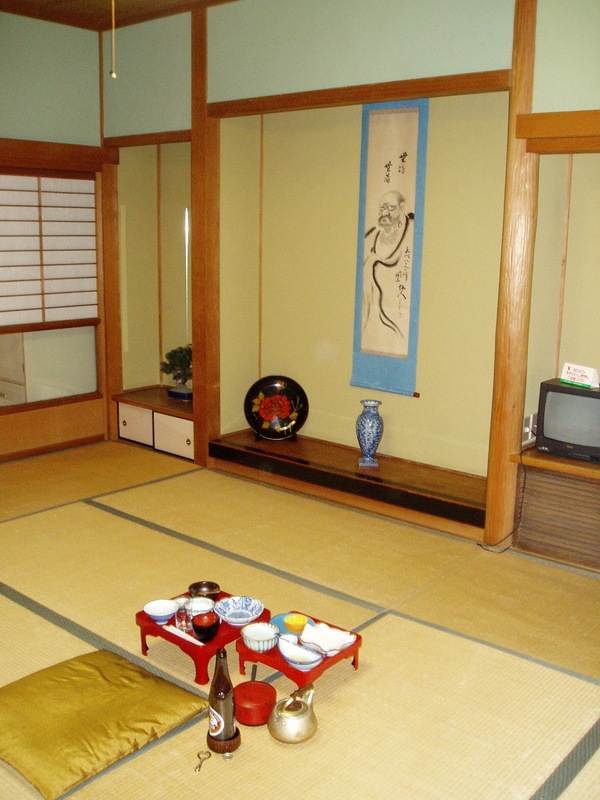
A typical room in a shukubo (with a typical dinner!, Okay, the dishes after dinner).
All
guests are invited to take part in the morning services held in
the shukubo, which really are temples, after all. Services
at the shukubo where I generally stay begin at 6:00am, not a problem at
all for the jetlagged, and since daylight begins around 5:00 in the
spring, not a problem for anyone else either. For the
pilgrims, it is part of the reason they came, and for the rest of us,
well, why not?
When I visited Koyasan in June of 2005, it was
with a specific purpose - to have a memorial service in honor of my
teacher, Otani Yoshiteru. Even though he was ostensibly a Shin
("New") Buddhist (any of a number of newer sects), I felt he
would have been pleased to be in such distinguished company as the
members of the Heike clan and their retainers, and the crowd of
royalty, samurai and local people in the centuries ever since.
The priest and his assistants chanted for about an hour. My job
was to add incense to the brazier in front of me whenever it
looked as though it would run out. Since sensei did not have a
Buddhist posthumous name, the officiants included his actual name in
the chant. It was virtually the only part that I
understood. Even though sensei died a whole year before, I
teared up every time I heard his name. The chant, accompanied by
cymbals and a gong, was both simple and moving. So
moving that, even after multiple visits, it has taken until now to
write anything on this subject at all.
This past spring, after a
surprisingly long speech by the abbot (I could not follow everything,
though I did take him up on his invitation to look over the shakunage
(mountain laurel) in full bloom around the town), we were invited
to walk around the sanctuary, where the assisting priest pointed out
some of its historical and artistic features. I could see
gold and black memorial tablets glowing out of the shadows; tablets
that are placed by relatives so the spirits of the
deceased can be comforted by daily services. As
usual, with my brain raised Protestant, I wondered how much money it
cost to keep them there, and what happened if, for example, someone's
heirs vanished - did they keep the tablets there, or retire them
somewhere? However, I was too polite to ask.
I returned
after the service to find breakfast served in my room, a repast that is
literally half the size that dinner usually is. Unless one makes
a request, lunch is usually foraged elsewhere. There are several
restaurants nearby that have a regular menu of Japanese and
Western-type foods (even meat!).
I should pause here to note
that staying in a temple involves rules. My travel agent
avowed that some westerners who have gone to Koyasan have found the
rules for temple guest houses onerous; and at least at my temple, they
cover one whole side of a piece of A4 size paper, single
space. Some highlights:
- Morning chant at 6am (voluntary)
- Breakfast at 7am (you must be awake and dressed)
- Lunch only served on request in advance
- Dinner at 5:30pm (no exceptions)
- Communal bath hours in the late afternoon/evening (there were no private baths, and no morning bath time)
- Temple gate locked at 8pm sharp (there is a side gate, but it is locked by 10pm)
Don't
like it? Tough. Stay at a hotel, but, personally, I have
never been bothered by the rules, except one time when I stayed out too
late at a bar, but I am getting off the track of my story.
There
are approximately 117 temples in Koyasan. "Temples" are
exclusively Buddhist, whereas the term "Shrines" refers to
Shinto. Ordinarily, one finds shrines and temples intermixed, as
Japanese are syncretic in their religious observances; however, in
Koyasan, temples dominate. They especially line the way to the
enormous graveyard that includes the Okunoin, the grand temple before
the tomb of Kobo Daishi sama himself. The main temple is
Kongobuji, a huge and very old wooden structure located not far from
the Daimon (great gate) that sits at one entrance to the town.
The abbot had suggested seeing the shakunage in bloom there, and I
grabbed my camera right after breakfast and went to take a look.
It was truly spectacular.
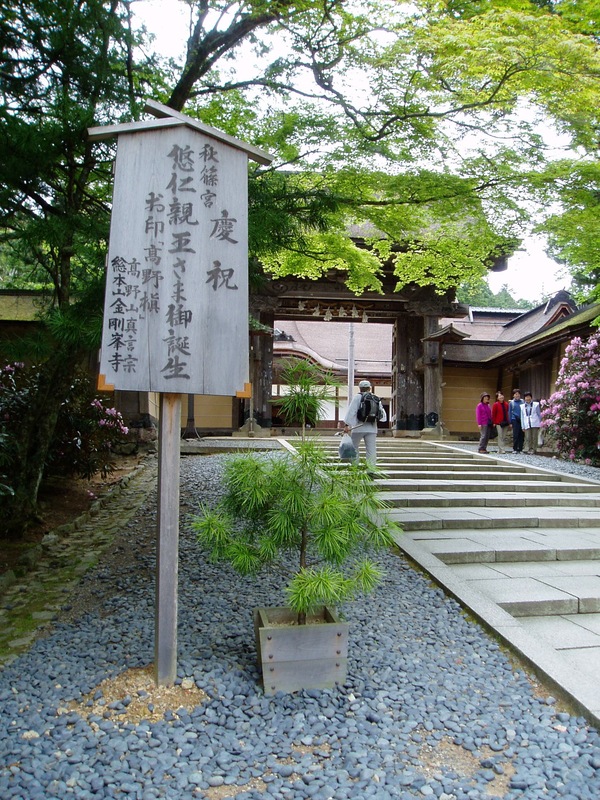
The entrance to Kongobuji.
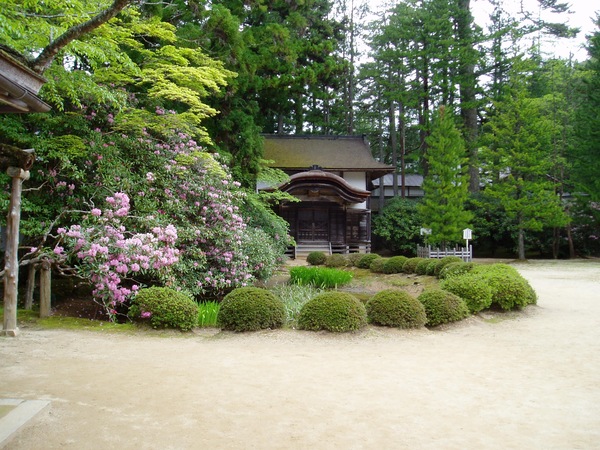 Spectacular Shakunage in bloom on the temple grounds.
Spectacular Shakunage in bloom on the temple grounds.
Kongobuji
is a very old wooden building, originally built by Toyotomi
Hideyoshi. Being very old wood, it is under continual maintenance
and repair. During my last visit, ladders were parked against the
front for some sort of chore to ensure its continued health.
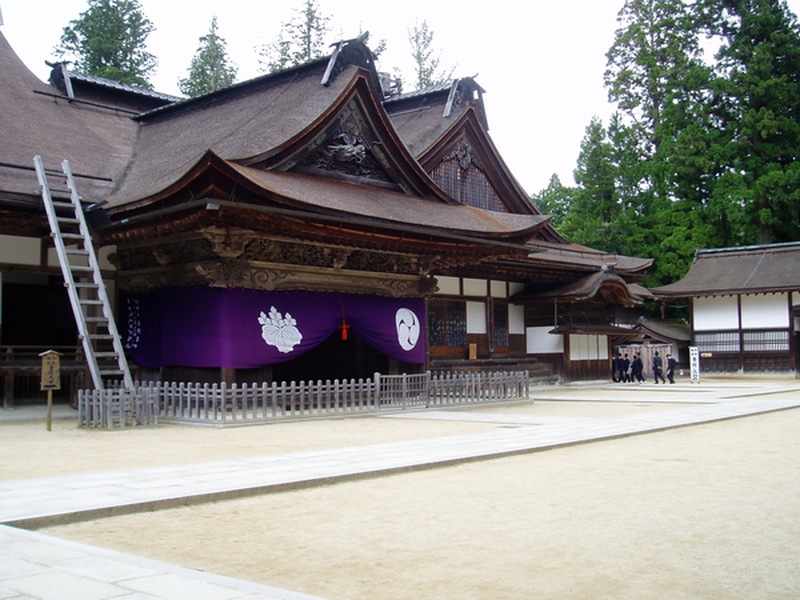 The main temple building, complete with ladder.
The main temple building, complete with ladder.
Across
the street from Kongobuji is the Reihokan, a museum that contains many
important Buddhist treasures. The wooden carvings have endured
the changes in weather on the mountain for centuries without any
special climate controls. A few years ago, when some of them were
lent to another museum for an exhibition, the artificial regulation of
temperature and humidity caused some of the pieces to crack! The
surmise is that the carvings do not like to leave the mountain, and so
they now stay where they are.
"I didn't know they
let women go there," one of my Japanese friends remarked, when I said I
was planning my first visit to Koyasan. He was partly
correct: women were not allowed within the city until 1872. Prior
to that time, women who made pilgrimages to Koyasan (including some of
the female characters in the Heike Monogatari) would have had to be
contented with stopping at one of the women's pavilions located at
several entrances to the town. The creation of the pavilions is
credited to Kongo Myojin, a woman who was said to be converted to
Buddhism by Kobo Daishi sama himself. There were originally seven
pavilions for women, but only one remains, now called the
Nyonindo. Outside the entrance is a small shrine dedicated to her
spirit. When I went there this spring, I had to wait outside
while a busload of mostly female pilgrims descended on the place,
stopping to chant a sutra before going further into town.
Fittingly, the chant was led by one of the women. After they
left, the man who was minding the place encouraged me to strike the
gong in front of the altar. I hesitated at first, then picked up
the mallet. I did not hit it very hard, but pretty firmly,
and the sound was sweet and very, very loud. The old man
laughed. Wherever the spirit of Kongo Myojin may be now, I am
certain she heard me.
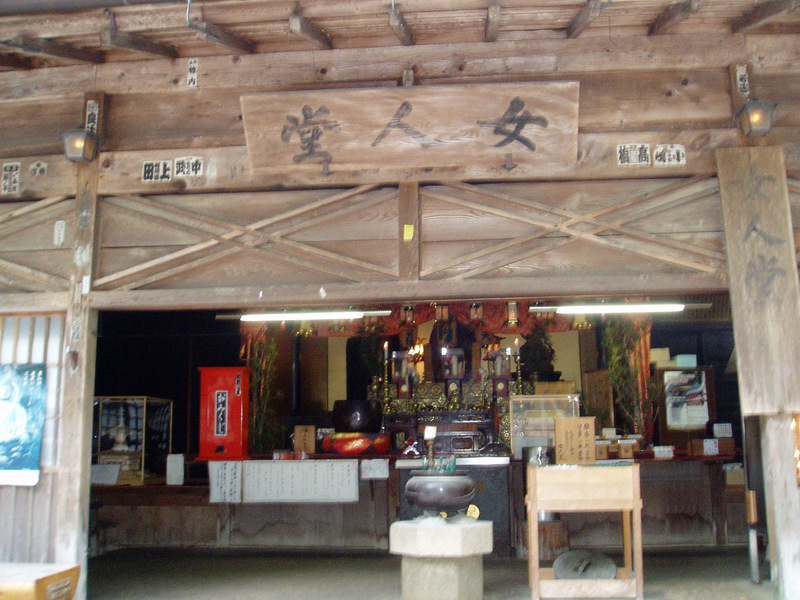
The Nyonindo.
The street
that leads to the cemetery is lined with temples, and also with
souvenir shops. Tourist buses of daytripping pilgrims park in
front of some of the largest of these, and everyone files out to take
advantage of the items on display. Religious items, such as
scrolls featuring portraits of Kobo Daishi sama, Buddhist statuary, and
rosaries etc. are among the most popular items of course.
Pilgrim's coats, staffs and hats are also for sale, though many of the
pilgrims I have seen are already wearing the customary white jackets
when they arrive.
After awhile, walking towards the cemetery,
the shops give way almost exclusively to temples. Some sit close
to the street, and, peeking in through their arches, one can
see welcoming entryways, often decorated with a carved wooden
screen and some artfully arranged flowers. Others are set back
and accessible by solemn-looking walkways that lead up to imposing
gates. I have never taken much time to explore any side streets
that might be around this area, but imagine the story is much
the same. Like the vast numbers of dead memorialized in the
graveyard, everyone wants to be close to the tomb of Kobo Daishi
sama.
The entry to the cemetery is by a simple stone
bridge at the end of the street. There are, by estimate,
over 500,000 graves here, though no one seems to know the exact
number. They extend on both sides of the path and off into the
distance. On one side, the area is bounded, at least at first, by
a highway and parking lot; the other side stretches up the side of the
mountain, where gravestones are hidden among the tall trees.
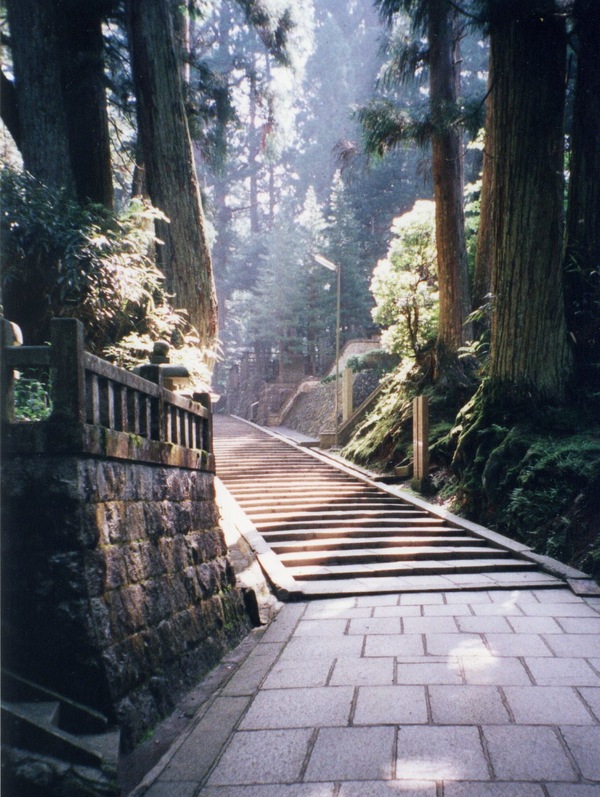 The walkway through the graveyard.
The walkway through the graveyard.
I
don't know how Japanese people feel encountering this place for the
first time, but for a thoughtful Westerner, the feeling is
difficult to describe. Both cultures have their superstitions,
but in my case, any sense of foreboding was quickly overtaken by
fascination. Japanese graves, especially old ones, are not
like modern Western graves. A famous, or at least well-off
Japanese person may have several gravesites. (Miyamoto Musashi,
the famous swordsman, has three.) Graves do not necessarily
contain bodies or even body parts; a lock of hair or an article of
clothing worn by the deceased will suffice. Needless to say,
anyone who was anyone over the past 1200 years has a grave at
Koyasan. Though some rough maps exist, new discoveries are
occasionally made. Even Oda Nobunaga, a 16th century would-be
unifier of Japan and destroyer of many temples, has a grave off the
main path, marked with a small wooden sign pointing the way.
There are official monuments for war dead from several countries,
family plots arranged similarly to what I might see at my local Calvary
Cemetery (St. Calixtus Division), as well as graves that no one
has any idea about. In addition, common people carved small
votives out of stone and left them here and there. Sometimes,
near the path, a close look at a random stone will reveal that it has
been carved and left to honor the memory of some loved one long ago,
half covered in dirt and moss. No names.
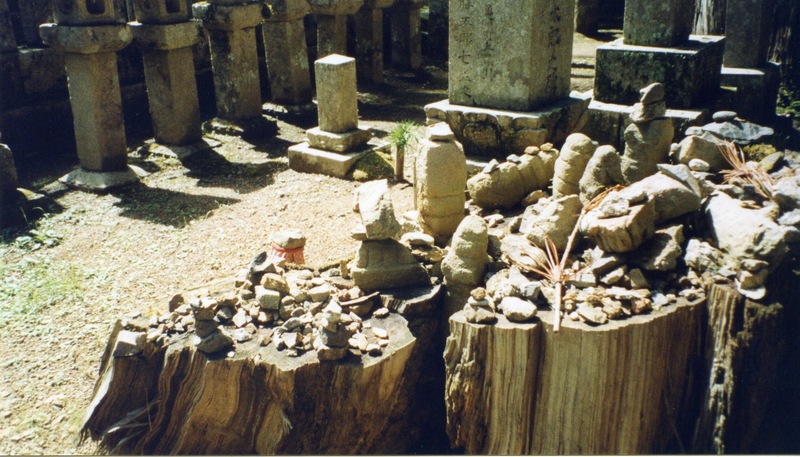
Stones and votive carvings left by pilgrims.
Gravestones
are sculpted in myriad ways; from classic-looking monuments to shapes
that I am fairly sure predate any current religious tradition.
There are Shinto torii fronting large, round stones with fluted
tops. Buddhist saints, such as Kannon-sama, the goddess of mercy,
top others. Some are large and impressive; others, like the
home-made carvings, humble and small.
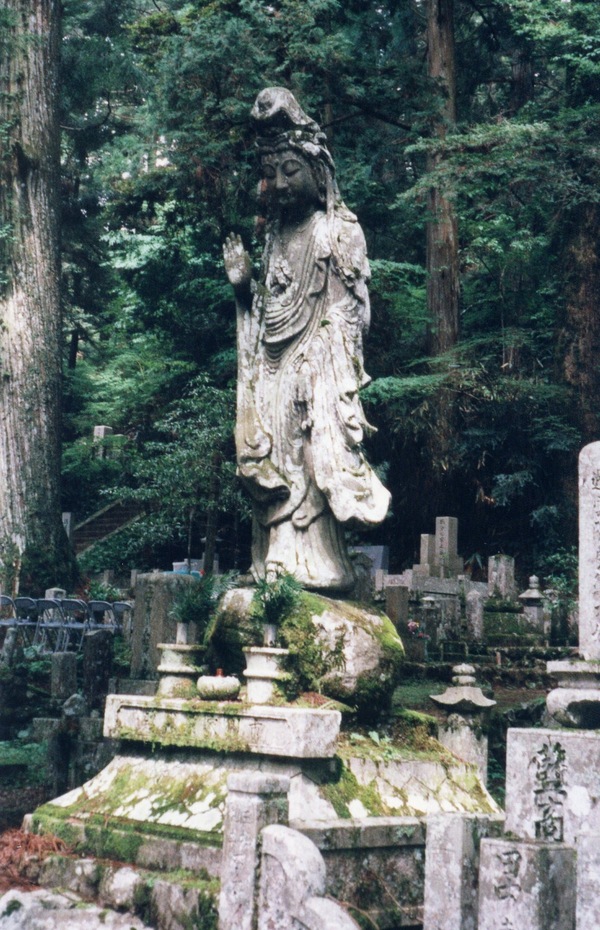
Kannon sama.
And just
in case a solitary walk through a giant cemetery scares or
intrigues? Forget about it. Even in a cold, persistent
rain, the path is filled with happy pilgrims, wearing their thin,
white jackets over their sweaters and windbreakers. On
one visit, I saw a group of novice monks undergoing initiation
trials, in their new robes and with newly-shaven heads. Though
quite a number of foreign tourists come to Koyasan all year round, they
still regarded me with some curiosity, or perhaps, unmonk-like, they
were seeking some distraction from the task at hand.
After
about 40 minutes' walk (depending on speed or lack thereof), up and
down gentle slopes and perhaps stopping at a monument or two, the path
reaches its dramatic end. On the near side, a visitors' pavilion,
complete with tables and chairs and tea for anyone who wants it; and
across another, larger stone bridge is the temple that fronts the
tomb of Kobo Daishi sama. Visitors are notified that no photos
are allowed as we cross the bridge and enter the temple area. As
I come closer, the smell of incense and candle wax hangs in the
air. Inside the temple itself, it is austerely dark, though with
the glint of gold of the temple furnishings. One of a team of
priests is chanting sutras with the help of a sound system. As in
any temple, there are offering boxes and small items for sale,
including candles, large and small, that can be marked with the
names of a devotee or loved one and lit in front of the altar,
providing a proportionate offering is made.
Outside the huge
wooden structure and around the back is Kobo Daishi sama's actual
tomb, a small, modest structure compared to the temple proper.
There are pots of sand for burning incense and racks for candles.
People are standing back and praying, politely leaving room for a
visitor to pass by. Though there is ceaseless activity,
there is also a sense of calm. The feeling is both intensely
emotional and somehow satisfying, even for someone who is not exactly a
pilgrim. Stop at the visitors' pavilion and have some tea, take a
look at the homemade art on the walls left by devotees. The walk
back through the cemetery is just as long as the one going in, the rain
just as cold and maybe even more penetrating, but the whole place feels
lighter somehow. Is it possible to have a gut understanding of
something that can't be grasped intellectually? I don't
know. Maybe the attempt to answer the question is what keeps
leading me back to Koyasan.
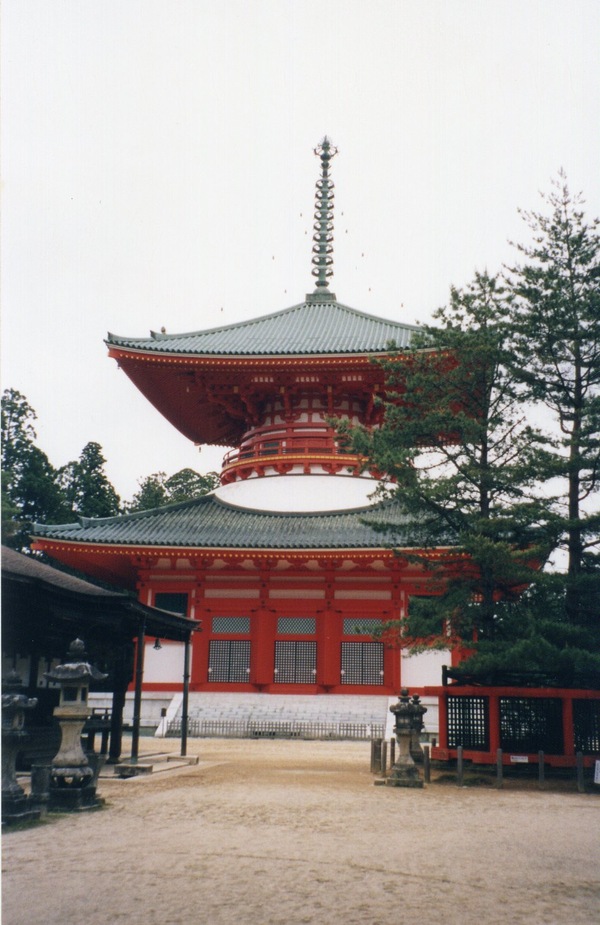
The Konpondaito
Works cited
Davis, F.H.
1992 Myths and Legends of Japan NY: Dover Pub.
Koyasan Sukubo Assoc.
n.d. A guide to Koyasan (brochure).
Thaler, M.
n.d. “The Monk and the Mountain” The Japan Times.





